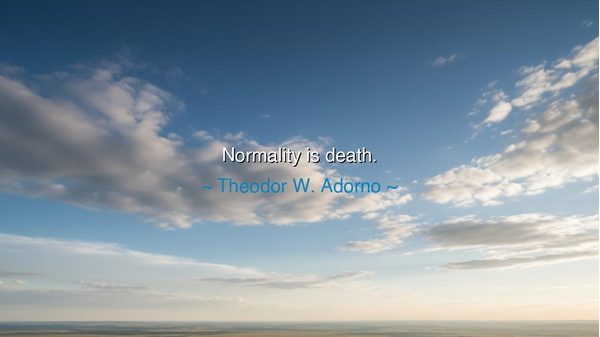
Normality is death.






“Normality is death.” — Theodor W. Adorno
Thus spoke Theodor W. Adorno, philosopher of exile and witness to the ruins of the twentieth century. His words are short, yet thunder with meaning — “Normality is death.” In this cry lies his rejection of complacency, of blind conformity, of the tranquil acceptance that numbs the spirit and silences the conscience. For Adorno lived in the shadow of catastrophe — he fled Nazi Germany, saw civilization collapse under the weight of obedience, and understood that the gravest horrors often arise not from monsters, but from those who simply wish to be normal.
To understand this saying, we must first know its origin. Adorno, a thinker of the Frankfurt School, sought to uncover how culture and society shape the mind. After the Second World War, he observed that humanity’s desire for comfort and conformity — its yearning for the normal — had allowed totalitarianism to thrive. Ordinary men followed orders; ordinary citizens looked away. “Normality,” then, was not the opposite of evil — it was its silent accomplice. Hence his verdict: normality is death, for when the soul ceases to question, it ceases to live.
The ancients, too, knew this truth. Socrates, that eternal gadfly, spent his life questioning the customs of Athens. For this, he was condemned to die. Yet as he drank the hemlock, he remained serene, knowing that a life lived without inquiry was a life already dead. He, like Adorno, understood that to live “normally” — to drift with the crowd, to accept without thinking — is to forfeit the divine spark of reason and courage. The living body may endure, but the soul withers in silence.
Consider the story of Rosa Parks, who, centuries after Socrates and decades after Adorno, refused to stand on that Alabama bus. Her defiance was not loud; it was quiet, human, and deeply alive. She broke the spell of “normality” — that invisible cage that told millions to accept humiliation as law. Through her act, the world was reminded that rebellion, when guided by justice, is not chaos but renewal. In her courage we see the antidote to Adorno’s warning: that true life begins where conformity ends.
Adorno’s words also echo in the heart of the artist, the dreamer, the creator. “Normality is death” means that creativity cannot breathe where there is fear of difference. The writer who dares to speak truth, the painter who disturbs comfort, the scientist who questions the known — these are the living. The rest, who bury their fire beneath routine, walk among the living as shades. Normality is the great anesthetic — it dulls the pain of awareness, but it also kills the pulse of wonder.
The philosopher’s warning is not a call to madness, but to awakening. He does not condemn peace, but passivity; not order, but the obedience that chokes the spirit. Life, in its truest form, is struggle — the struggle to think, to create, to love, and to resist the slow decay of indifference. The moment we choose ease over truth, comfort over conscience, we begin to die, not in body, but in meaning.
So let this teaching be carried forward: do not seek to be normal — seek to be alive. Question what is given. Resist the dullness that calls itself peace. Speak when silence is safer. Dare to see beauty where others see nothing. For in the courage to be different lies the essence of humanity. As the ancients said, “A ship is safe in harbor, but that is not what ships are built for.”
And so, Adorno’s words echo across the ages — not as despair, but as commandment: rise above the sleep of normality, and live with eyes open. For the heart that dares to feel, the mind that dares to think, and the spirit that dares to defy the ordinary — these alone are truly alive.






AAdministratorAdministrator
Welcome, honored guests. Please leave a comment, we will respond soon